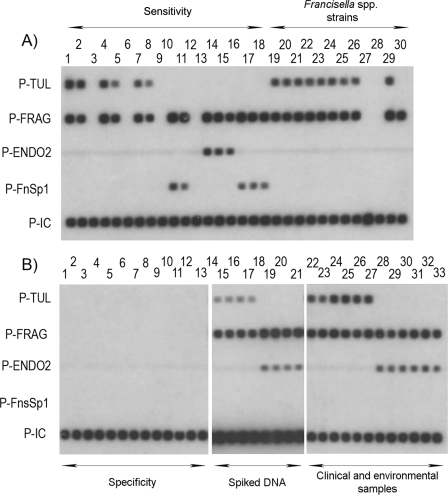FIG. 2.
RLB results of different samples, as in Table 2. (A) Lanes 1 to 3, 102, 10, and 1 GE, respectively, F. tularensis subsp. holarctica strain LVS; lanes 4 to 6, 102, 10, and 1 GE, respectively, F. tularensis subsp. tularensis strain B-38; lanes 7 to 9, 102, 10, and 1 GE, respectively, F. tularensis subsp. novicida strain Utah 112; lanes 10 to 12, 102, 10, and 1 GE, respectively, unusual F. tularensis isolate FnSp1; lanes 13 to 15, 102, 10, and 1 copy, respectively, of plasmid FLE; lanes 16 to 18, 102, 10, and 1 copy, respectively, of synthetic DNA of F. tularensis subsp. novicida-like isolate 3523; lane 19, strain FSC 257; lane 20, strain FSC 012; lane 21, strain FSC200; lane 22, strain FT7; lane 23, strain FT13; lane 24, strain BZO20; lane 25, strain BZO21; lane 26, strain BZO22; lanes 27 and 28, F. philomiragia strains CCUG 12603 and CCUG 19701, respectively; lanes 29 and 30, F. tularensis subsp. novicida strains Fx1 and Fx2, respectively. (B) Lane 1, negative control (water). Lanes 2 to 13 show the results of specificity assays and reactivities of different Francisella strains: lane 2, Anaplasma phagocytophilum; lane 3, Borrelia burgdorferi sensu stricto; lane 4, Coxiella burnetii; lane 5, Legionella pneumophila; lane 6, Rickettsia conorii; lane 7, Orientia tsutsugamushi; lane 8, Mycoplasma pneumoniae; lane 9, Chlamydia pneumoniae; lane 10, questing Ixodes ricinus ticks from the Basque Country (3); lane 11, Rhipicephalus sanguineus; lane 12, C3H mouse DNA; and lane 13, human DNA. Lanes 14 to 17 contain DNAs of different origins spiked with 10 GE of F. tularensis subsp. holarctica strain LVS: lane 14, I. ricinus; lane 15, R. sanguineus; lane 16, C3H mouse DNA; and lane 17, human DNA. Lanes 18 to 21 contain DNAs of different origins spiked with 1 copy of plasmid FLE: lane 18, I. ricinus; lane 19, R. sanguineus; lane 20, C3H mouse DNA; and lane 21, human DNA. Lanes 22 to 27 contain clinical samples, including four lymph node aspirates (lanes 22 to 25), one skin exudate (lane 26), and one skin biopsy specimen (lane 27) from patients with tularemia. Lanes 28 and 29 contain samples from the small mammal Apodemus sylvaticus. Lanes 30 to 33 contain samples from ticks.

